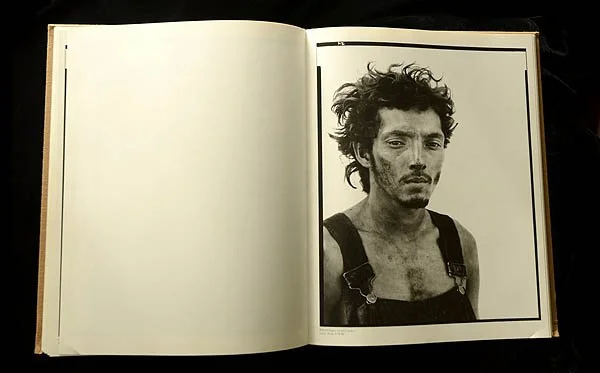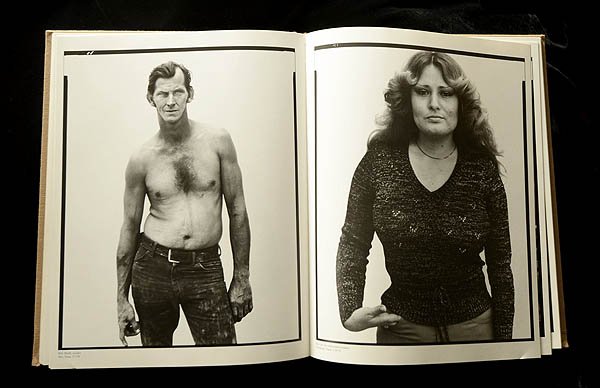In the American West
Richard Avedon
Harry N. Abrams, 1985
174 pages, Hardcover 11" x 14"
Reviewed by Tim McLaughlin
Considered by many to be Avedon’s magnum opus, the work was controversial when it was published for depicting marginalized subjects. To a public used to a romantic notion of the west, Avedon's work was thought distopic. It was also felt that Avedon, firmly established in New York City, was voicing a critical opinion of the American West. The book retains its provocative qualities to this day.
It is difficult to separate the publication from the project of making the photos and from the exhibition of the completed work at the Amon Carter Museum in 1985. Fortunately, photographer Laura Wilson, who worked as an assistant to Avedon and wrote the “Background” essay in the book, has also given additional valuable information about this project in her own book Avedon at Work: In the American West.
The book itself follows the model of previous Avedon books. Large format, 14 x 11 inches, with 103 plates and a three-page gatefold. In contrast to the groundbreaking design of Observations (the work of Alexey Brodovitch) In the American West is all about the photos. The typeography is pristine and understated. But, as elegant as the presentation is, it gives no indication as to the far-reaching scope of the project or the resources that went into it. Avedon worked for six years, from 1979 to 1984, visiting 17 states and 189 towns to do 752 sittings. He was working with a Deardorf 8 x 10 view camera. At today’s prices the cost of film alone would have been close to $70,000 for the 17,000 sheets he exposed. All but 123 of the negatives were intentionally destroyed when the project was completed. The 123 remaining negatives are in the collection of the Amon Carter museum, with the photographer’s directive that they never be printed from again.
The portraits are remarkable. As with much of Avedon’s work it is difficult to state exactly what the qualities are that make these images so arresting. Each day, as we go through the world, we encounter individuals. Most of us are naturally curious about them. But it is impossible to stop a stranger in the streets and say to them, “Hold on just a moment, please. There is something about you that is striking to me. Can you just stand here for a bit while I try to get a sense of you … while I attempt to discover who you are?” Of course it is a voyeuristic enterprise, but it is also an entirely photographic one—executed by a master.
At the heart of the book's controversial reception are two ideas. The first is the most complex: by focusing on oil-rig drillers, abattoir-men, drifters, ranchers, and carnie-workers is Avedon exploiting his subjects or complementing them? Thirty years after the photos were taken, both answers are equally valid.
Established as perhaps the most famous fashion and celebrity photographer, many saw Avedon’s work as placing the working class and marginalized on a stage usually reserved for the talented and beautiful. In the context of the mid-1980s, when television was controlled by networks and conglomerates dictated the content of most mass media, Avedon elevated the subjects and showed that they were also worthy of interest and attention.
Some critics, on the other hand, clearly saw the subjects as victims. As Max Kozloff stated:
The blank, seamless background thrusts the figures forward as islands of textures of flesh, certainly, but also of cloth. Nothing competes with the presentation of their poor threads, nothing of the personal environment, nothing that might situate, inform, and support a person in the real world, or even in a photograph. At the same time, the viewer is left in no doubt about the miserableness and tawdriness of their lives- for their dispiriting jobs or various forms of unemployed existence are duly noted. An ugly comparison is invited between all these havenots and Avedon’s previous and much better defended “haves.” It is one thing to portray high-status and resourceful celebrities as picture fodder: it is quite another to mete out the same punishment to waitresses, ex-prizefighters, and day laborers.1
It is clear that Avedon understands the role of art. And, no matter how much he would control the shoots, the negatives, the retouching, and the final presentation, he does not attempt to control our interpretation of the subjects. We are free to think them heroic individuals or hapless victims. Kosloff is correct in this much: Avedon will not provide a setting that explains the portraits. We look into the face of another individual and we must provide our own interpretation. It is this facet, more than anything else, that makes the work uncomfortable, but also invaluable.
Avedon’s relationship with the subjects is not a simple one. At times he maintains that his subjects are to him what clay is to a sculptor. Ten years after the book was published, Avedon returned to connect with some of the subjects. Sandra Bennett was twelve when her portrait was taken. Six years later she was eighteen and on the cover of the book. When they reconnected Bennett maintained that the photo was not who she really was. Avedon is lucid in his response:
You can’t say you weren’t in the picture—that’s what’s so confusing about photography. You can’t say you weren’t there. But you have to accept that you are there and the control is with the photographer. I have the control in the end. But I can’t do it alone. You have a lot to say, and by that I mean, the way you look, the way you confront the camera or the experience, whether you’re trusting or not trusting. In the end I can tear the pictures up, I can choose the smiling one … or the serious one … or I can exaggerate something through the printing. It’s lending yourself to artists.2
This tension is familiar ground for Avadon. Anticipating some of the criticism to come, the book contains what is today his most famous quote. It is worthwhile giving the entire short paragraph:
A portrait is not a likeness. The moment an emotion or fact is transformed into a photograph it is no longer a fact but an opinion. There is no such thing as inaccuracy in photographs. All photographs are accurate. None of them is the truth.3
The second objection to In the American West when it was issued is more easily dealt with. The book is not representational of the West. Fair enough. It’s not representational. Shoots done with U.S. Olympian Sis Wigglesworth, were not included and Wilson states that “Dick never used her portrait—he felt her privileged world set her apart from the other people he’d photographed for his project.”4
Avedon was clear that the project was not journalism or reportage. It was his opinion and it was no more an objective truth about the west than John Wayne might be.
It is worth considering for a moment Avedon’s approach to “exaggerating something through the printing.” The prints produced for the exhibition at the Amon Carter Museum were produced by traditional photochemical means. It would be another five years before photoshop 1.0 was released and many additional years before digital processing could handle the scale that Avedon needed. It would have been common practice to lighten, darken, (dodge and burn) areas of the photo and to increase or decrease contrast through the selection of film and paper stocks. Today’s digital photographers are sometimes under the misapprehension that film shooters did not alter images, but in fact almost nothing would have left Avedon’s studio without detailed manipulation.
We are fortunate that Avedon himself published some of the printing notes in his book Evidence.5 The image above does not represent a set of instructions from Avedon to the darkroom. Rather it is a dodge and burn map made by Ruedi Hoffman, as he laboured with David Liittschwager to produce the effects Avedon requested. According to Wilson:
Ruedi and David started with a set of 16-by-20-inch prints. Dick rejected them all. He felt that the tone was heavy; they were too black and had too much contrast. In reprinting Dick’s directions were rarely technical. He would say simply, “Make the person more gentle,” or “Give the face more tension.” This unconventional advice forced Ruedi and David to try to understand the emotional content that Dick sought in each portrait.
Once you have seen the dodge and burn map and looked at the finished portrait, the manipulations are visible. The face of Billy Mudd for example, acquires a strange mask-like quality which seems to be the result of intentional lightening. It is a peculiar flaw in an otherwise immaculate body of work.
The final prints are huge. Most were printed at a size of almost 4 x 5 feet. With ten printed even larger at 5 x 7 feet. The effect of the size and the detail of the 8 x 10 view camera combine to make a formidable image. “But really, I feel that these people are so powerful. When you look, really look, they say such varied things with their faces and their bodies. Its almost as if there was no photographer. I’m out of it. I feel the work now belongs to the people themselves. It’s between them and you.”
1. "Richard Avedon's In the American West" by Max Kozloff. Originally published in Art in America (January I987). Accessed at: http://www.zonezero.com/magazine/articles/kosloff/pagina1Avedon.html
2. American Masters Series (video). Richard Avedon: Darkenss and Light. 1995.
3. In the American West Richard Avedon. Harry N. Abrams. 1985.
4. Avedon at Work: In the American West Laura Wilson. University Of Texas Press. 2003
5. Evidence Richard Avedon. Whitney Museum of American Art Exhibition Catalogue. 1994













